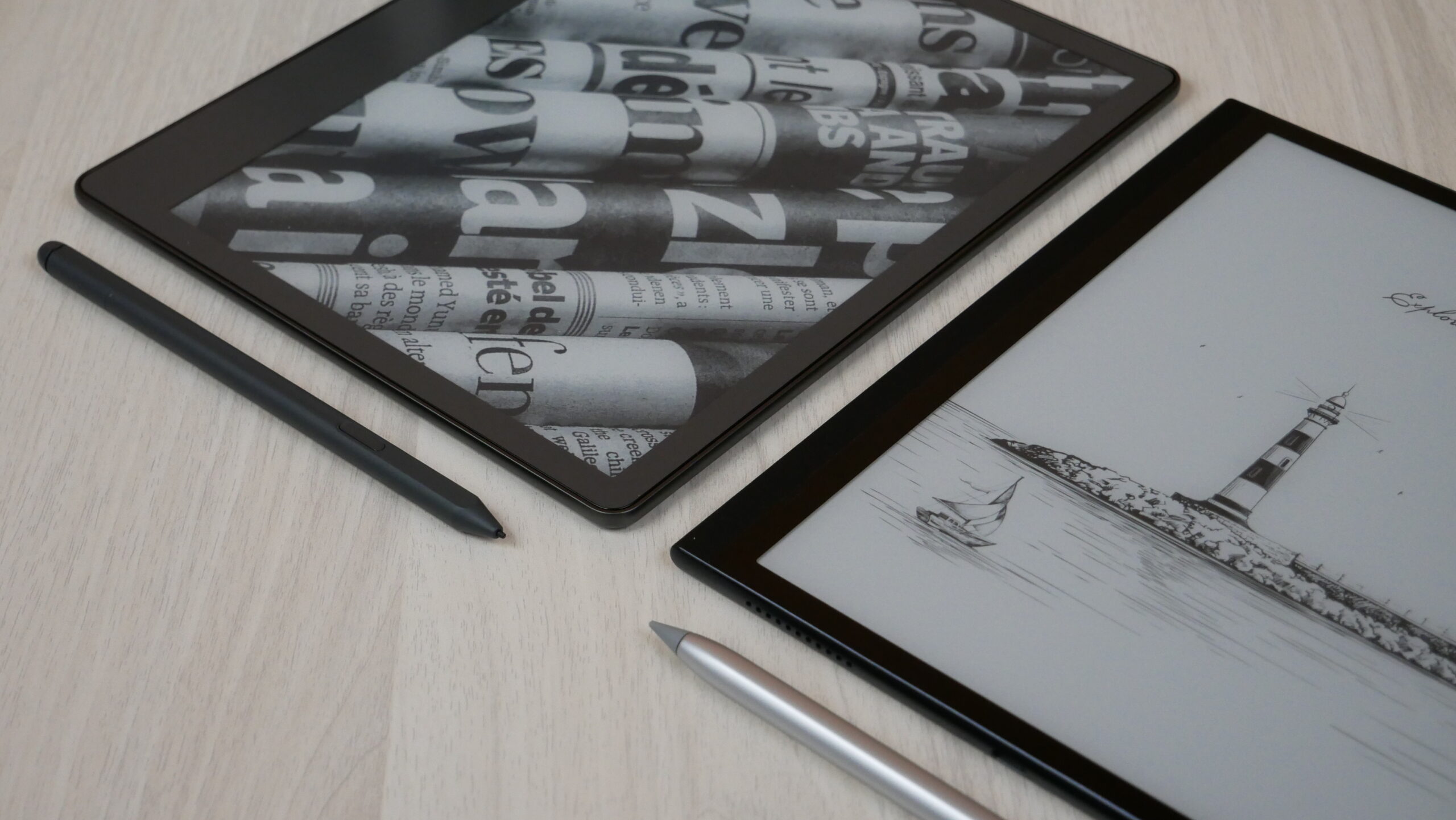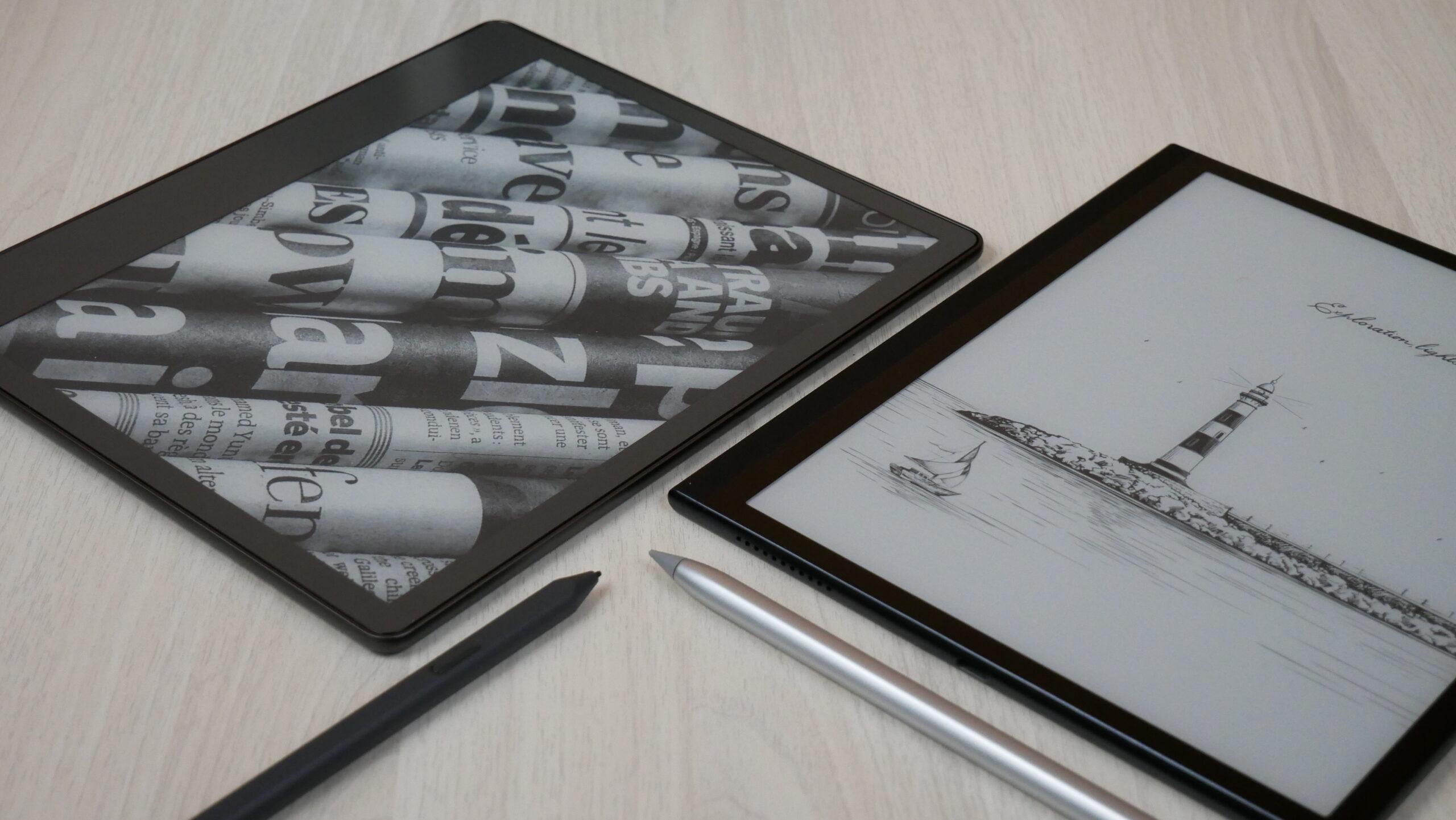Kobo has been the first among the big three to launch an e-note device. Prior to that, we had e-note devices from a clutch of Chinese companies along with a few others such as Remarkable. Amazon surprised us all by coming up with its own take on an e-note device in the form of the Kindle Scribe.
Meanwhile, on the other side of the globe, Huawei had something similar up its sleeve in the form of the MatePad Paper. It was also the first among the prominent tech companies in China to come up with an e-note device, something that perhaps none had expected. Interestingly, with both the devices, it is a classic case of so near yet so far sort of a scenario. Both the Scribe and the MatePad Paper are excellent devices in their own right but still fail to make the mark by a mile. Read on to find out how.
Style, Build, and Display
Both the Kindle Scribe and the MatePad Paper sport similar designs in that they have a thicker left bezel compared to them being thinner on the remaining sides. This might look slightly off but makes for a more practical design option considering that the thicker left ledger provides space for holding the device with the left hand while you operate it with the right. The lefties will just have to turn the device around to hold the thicker edge while working with their left hand.
However, with the MatePad Paper, you have a dual-color left ledger perhaps to indicate how much is the actual bezel and how much extra room is available for ease of holding the same. The Scribe keeps things simple in that there is no dual-colored left bezel. Rather, all of it is done up in a single shade that you will find making up the rest of the body as well. Nothing wrong with either design scheme as both look good and are solidly built.
In fact, things might be considered a bit more enticing with the MatePad Paper considering that there is a leather textured finish for the entire rear surface which wraps around the front ledger as well, leaving out the portion that can be considered the left bezel of the device. It makes things look cool and offers a non-slippery surface to hold the device. With the Scribe, it’s a metal build all through but has four rubber stoppers at the four corners that help in keeping the device planted on a surface.
Further, while both have impeccable build quality, it is the MatePad Paper that has thinner bezels with the left ledger too being comparatively thinner compared to the Scribe. That makes it the overall better-looking device. The Scribe, on the other hand, is slightly bigger even though it has a display that is a tad bit smaller. Also, with the thicker bezels and left ledger, the Scribe has that sort of a dated look to it while the MatePad Paper looks more sharp, slick, and modern.
While still on the display it’s E Ink for both though the Scribe has 10.2 inches of it while the Huawei offering comes with a 10.3-inch E Ink display. However, the Scribe is one-up here considering that the 10.2-inch display comes with a 300PPI resolution, which makes it the only device in the 10+ inch category to be so equipped. E Ink said it is a completely new E Ink display tech that uses a higher resolution TFT, something that Amazon has exclusivity with for an unspecified period of time before others start getting to use the display tech. Huawei offers a more conventional E Ink display having 227 PPI resolution.
Hardware Specs
The Kindle Scribe comes in three variants offering 16, 32, and 64 GB of storage but lacks microSD card support. As already stated, the 10.2-inch E Ink touchscreen display offers 300 PPI pixel density. It comes with 35 LED front light support having adjustable warm light. It comes with a choice of either Basic or Premium pens. Both are similar save for the Premium pen featuring an eraser at the top as well as a programmable physical button along its side. The basic pen lacks an eraser though you can program the side button to function as an eraser or some other feature.
Amazon is claiming up to 3 months of run time on a single charge and can be recharged via the USB-C port it comes with. It does not come with a wireless charging feature while the charging brick too has to be bought separately. It isn’t waterproof though and lacks an integrated speaker as well as a 3.5mm headphone jack. It measures just 5.8 mm in width and weighs 433 grams. Under the hood lies a 1GHz MediaTek MT8113 processor coupled to 1 gig of memory.
The MatePad paper, on the other hand, comes with a 10.3-inch E Ink Carta HD display having a resolution of 227 PPI. It offers 32-level brightness and boasts an impressive 86.3 percent screen-to-body ratio. It also features a smart refresh rate that allows for automatic adjustment of the display refresh rate to allow for optimum battery usage. The M-Pencil comes bundled with offers 4096 levels of pressure sensitivity.
Powering the device is the Kirin 820E 5G and Mali-G57 6-core GPU. There is 4 gigs of memory onboard along with 64 GB of storage. Connectivity options include Wi-Fi 6+ and Bluetooth 5.1 while there is the US Type-C port as well for charging and data transfer. The 3,625 mAh battery it comes with is backed by 22.5W fast charging support. It comes with a fingerprint sensor and weighs significantly less at 305 grams.
Note-taking experience
It is here that the two begin to drift apart far and wide. Both have their high and low points though what can’t be denied is that both leave us wanting for a lot more than what they have to offer at the moment.
To get into the matter right away, the Kindle Scribe comes with the option of two pens. They are nice and comfortable to hold and have standard tips. They don’t need to be charged too, which is a huge plus. Further, the pen is available to write on the device right away. You can even use it for touchscreen connectivity as well. What that means is the pen can be used to imitate various finger tap operations, something that is not possible with the Huawei pen. Also, since Amazon is using Wacom on the Scribe, it can support a whole lot of other pens as well.
The Huawei pen, on the other hand, is a huge disappointment. With a silver-colored finish, the pen looks unique and nicely built. However, the biggest issue with the pen is the writing experience it offers, which makes you feel like trying to write on a piece of glass with a pen having a rubbery tip. We might be used to some amount of friction while writing with a real pen on real paper though that’s definitely not the sort of friction that rubbery stuff creates when pushed against a glass surface. Rather than having some friction, the pen offers a sticky feel with almost zero feedback.
If that is not all, the Huawei pen can’t be used right away. Rather, it has to be connected to the e-note via Bluetooth before you can start using it. Fortunately, establishing a connection is easy as you just have to attach the pen to the side, which happens via magnetic action. Once that is done, a notification pops up which says that Bluetooth will be enabled. Once you have tapped on the Connect button, you can start using the pen. That way, you will have to keep your Bluetooth connection on till the time you are using your pen. Further, the pen needs to be charged periodically, which is another low point with the pen.
That said, the pen is fast and responsive with almost zero lag times. Pressure sensitivity is good too. A cool feature of the pen is that double tapping on its side will invoke the eraser, which makes it similar to the Apple Pencil. Double tapping the same with put it back to writing mode. In fact, the MatePad Paper is more tuned to serve as a digital note-taking device than the Kindle Scribe. This is evident from the sheer number of writing options that the MatePad Paper comes with compared to just a handful of it on the Scribe.
More specifically, what you have with the Scribe is a small palette that appears on the side and offers a few writing functions. Those include the pen, the highlighter, touch, undo, and redo options. Lastly, there is the move to the right or left option which simply moves the palette to the right or the left side of the screen. There are no multiple pen options, colors, text input, layers, shades, and such. A feature as basic as cut, copy, and paste is missing too. You can’t even make text input on PDF files that you have sideloaded. Rather, that would be possible only on only those PDF files that you have loaded onto the device via the ‘send to Kindle’ feature.
With the MatePad Paper, you have a whole bunch of writing options that should have all your needs covered. You have different pens to choose from, cut-copy-paste options, voice recordings, insert images, adjust text size, and so on. Other options you have include converting handwriting to text and such. In short, you will have everything you need, and then perhaps more with the MatePad Paper so far as note-taking is concerned. Unfortunately, the very piece of tech that will let you use all the writing options is also the biggest bane with the device.
Coming to the respective ecosystem that each device conforms to, here again, the Scribe is the clear winner. Amazon offers a more elaborate ecosystem that is comprehensive, well thought out, and arranged, and has a better variety. You have e-books, manga, graphic novels, magazines, editorials, and audiobooks. All of that makes plenty of content to deal with, something that Huawei just isn’t able to match up to. However, the good thing with the Huawei offering is that it supports side-loading of Android apps even though it runs the Harmony OS.
Conclusion
We don’t have a clear winner here. The MatePad Paper is more modern and slick compared to the Scribe which might look slightly dated when placed side by side. Also, even though both manufacturers are projecting their individual devices as e-notes, that clearly isn’t the case with the Kindle Scribe. Rather, the Scribe is more of a large-screen e-reader – you can take it as a successor to the Kindle DX of yore – with note-taking capability coming in as an afterthought. The display is brilliant, and so are the build quality, the ecosystem, and the pen.
However, if you are looking for an e-note device, the MatePad Paper is clearly the better alternative given the huge note-taking options it has on offer. It also is a lot lighter than the Scribe as well. Unfortunately, the very thing that Huawei uses to justify its e-note branding betrays the purpose miserably. Apart from the pen, the Huawei ecosystem too is another area where it lags behind the Scribe by a significant margin. If you can live with these shortcomings, the Huawei device is the one to go for. Else, opt for the Kindle Scribe and hope Amazon comes up with the promised note-taking features soon enough.
(adsbygoogle = window.adsbygoogle || []).push({});
The post The Amazon Kindle Scribe vs Huawei MatePad Paper – which is the better e-note device first appeared on Good e-Reader.


